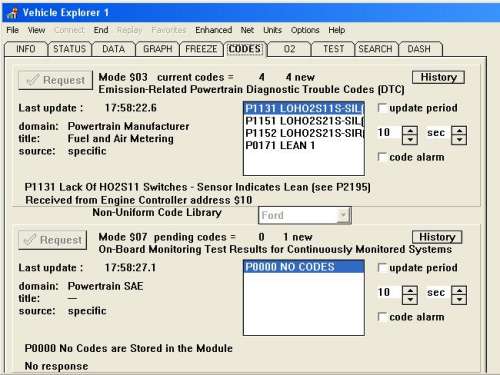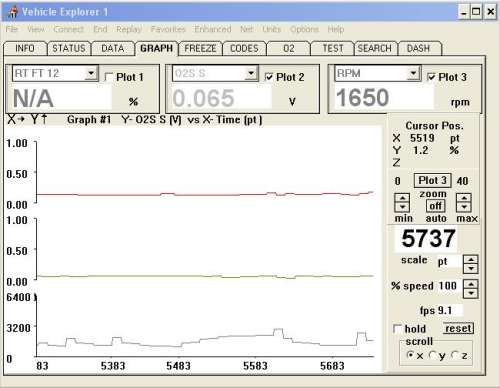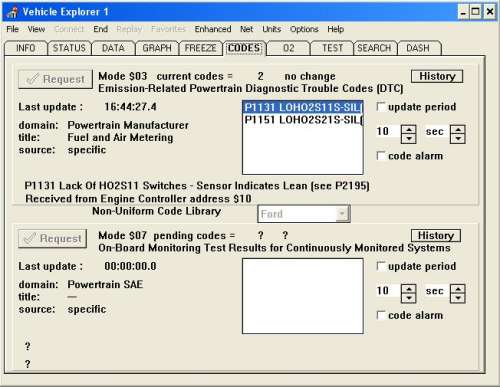OBD2 Fault Codes - Poor Running
Brett is the owner of a very nice Aubergine 24V Cosworth saloon.
Last year he was experiencing poor running at cruising. The engine was
hesitating and we immediately suspected the EGR system, because leaks here can
cause excessive leaning during EGR operation. Sure enough, the EGR pipe was
loose. It wasn't rattling about, but it was not rigid.
Brett installed new HT leads and asked for the EGR pipe to be tightened at his
local Ford garage. Missing seemed less, but the engine performance was worrying.
The engine was sluggish, and hesitated until Brett pressed on the accelerator,
so we tried an OBD scan.
At this stage, the OBD system did not seem concerned about the EGR - it had more
important things to worry about - the HO2S sensors were giving trouble:

This had to be sorted. The HO2S sensors 11 and 21 are used for
fuelling. When they indicate rich the EECV PCM switches fuelling to lean, and
vice versa. This is important, because the modern Fast Light Off three-way
catalysts absorb oxygen in a lean mixture and the catalytic operation slows
down. The mixture has to be enriched to force the catalyst to give up the oxygen
and keep it at maximum efficiency. Changing the mixture constantly from slightly
rich of stoichometry (the theoretically ideal mixture of fuel/air) to slightly
lean enables the catalyst to operate at virtually 100% efficiency. In Brett's
case, though, the catalysts had passed their best. Both post-cat sensors were
switching almost as fast as the upstream ones and his emissions were too high.
Brett paid for new pre-cat HO2S (HEGO) sensors and catalysts. But the engine
performance actually worsened at this point. The car was running raggedly, and
stalled frequently: the engine seems to die until he put his foot on the
accelerator, and then it would pick up again. After all this money spent, the
car seemed to be worse than ever before!
Brett bought his own OBD lead, ran the Vehicle Explorer on the HO2S sensors and
e-mailed the resulting scan to me. This was a surprise! The car was not even
reaching closed-loop operation - it was staying on open loop cold start
fuelling. How do we know that? Below, the DATA page showing the numbers as they
are read from the sensors:

Above, the tell-tale status message read from PID $03. I have
highlighted it so that the explanation text shows on the bottom of the window.
'Fuel System status is Open Loop due to detected system fault.' But what's this?
Both front HO2S sensors are new! How can there be a fault?
Looking at the HO2S sensors the numbers seem to be suspiciously low - no
'switching' is apparent at all. Graphing them confirms my suspicions -

Yes. Both the front sensors are dead. With the ECT showing full
temperature, the Catalyst and Fuel operation should now be well into Closed Loop
- but here the front sensors are not responding at all. The red trace at the top
is the Bank 1 sensor (drivers side) and the brown trace on the second plot the
Bank 2 sensor. The RPM line showing where Brett revved the engine is more
interesting (bottom trace) This is confirmed by the DTCs shown on this scan,
showing, as expected, that the sensors were not switching:

P1131 and P1151, as expected (Lack of switching, sensors
indicating lean).
These sensors could not be new. Brett looked at the engine again, and found that
the garage had replaced the Post-Cat sensors and left the important fuelling
sensors alone. Perhaps they had been confused by the wiring length for the new
ones from Ford. The front sensors have been deleted from the catalogue and the
wiring for the front sensors have to be cut and soldered using the old wire to
make them fit. They had probably fitted the sensors where the wiring indicated
them to be!
Brett had the sensors swopped, and the running instantly improved.
Hesitation/stalling stopped and miles per gallon improved greatly.
Now that closed loop operation had been restored, Brett found a single EGR error
- P0401, Insufficient Gas detected. No, Essex Ford had not tightened the EGR
pipe! Nevertheless, after the sensors saga, the car was driveable again, and
Brett knew exactly what still needed to be done.
This shows the advantage of the Vehicle Explorer software. System faults
hitherto only available to the professional garage can be read by any owner even
where a mistake has been made by a garage.
Thanks to Brett for the scans.

![]()
